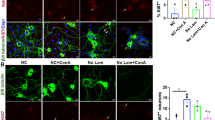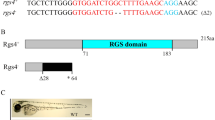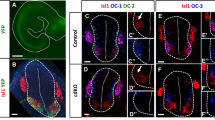Abstract
Embryonic sensory and motoneurons depend on neurotrophic factors for survival. Here we show that their survival requires B-Raf, which, in this function, cannot be substituted by C-Raf. Sensory and motoneurons from b-raf-deficient mice do not respond to neurotrophic factors for their survival. However, these primary neurons can be rescued by transfection of a b-raf expression plasmid. In contrast, c-raf-deficient neurons survive in response to neurotrophic factors, similarly to neurons from wild-type mice. This points to an essential and specific function of B-Raf in mediating survival of sensory and motoneurons during development.
This is a preview of subscription content, access via your institution
Access options
Subscribe to this journal
Receive 12 print issues and online access
$209.00 per year
only $17.42 per issue
Buy this article
- Purchase on Springer Link
- Instant access to full article PDF
Prices may be subject to local taxes which are calculated during checkout





Similar content being viewed by others
References
Kaplan, D. R. & Miller, F. D. Neurotrophin signal transduction in the nervous system. Curr. Opin. Neurobiol. 10, 381–391 (2000).
Maina, F. & Klein, R. Hepatocyte growth factor, a versatile signal for developing neurons. Nat. Neurosci. 2, 213–217 (1999).
Baloh, R. H., Enomoto, H., Johnson, E. M. Jr. & Milbrandt, J. The GDNF family ligands and receptors—implications for neural development. Curr. Opin. Neurobiol. 10, 103–110 (2000).
Wang, H. G., Takayama, S., Rapp, U. R. & Reed, J. C. Bcl-2 interacting protein, BAG-1, binds to and activates the kinase Raf-1. Proc. Natl. Acad. Sci. USA 93, 7063–7068 (1996).
Wang, H. G., Rapp, U. R. & Reed, J. C. Bcl-2 targets the protein kinase Raf-1 to mitochondria. Cell 87, 629–638 (1996).
Michaelidis, T. M. et al. Inactivation of the bcl-2 gene results in progressive degeneration of motoneurons, sensory and sympathetic neurons during early postnatal development. Neuron 17, 75–89 (1996).
Grewal, S. S. et al. Neuronal calcium activates a rap1 and b-raf signaling pathway via the cyclic adenosine monophosphate-dependent protein kinase. J. Biol. Chem. 275, 3722–3728 (2000).
Wojnowski, L. et al. Craf-1 protein kinase is essential for mouse development. Mech. Dev. 76, 141–149 (1998).
Wojnowski, L. et al. Endothelial apoptosis in Braf deficient mice. Nat. Genet. 16, 293–297 (1997).
Wiese, S. et al. The anti-apoptotic protein ITA is essential for NGF-mediated survival of embryonic chick neurons. Nat. Neurosci. 2, 978–983 (1999).
Perrelet, D. et al. IAP family protein delay motoneuron cell death in vivo. Eur. J. Neurosci. 12, 2059–2067 (2000).
Muszynski, K. W. et al. Raf-1 protein is required for growth factor-induced proliferation of hematopoietic cells. J. Exp. Med. 181, 2189–2199 (1995).
Wojnowski, L., Stancato, L. F., Larner, A. C., Rapp, U. R. & Zimmer, A. Overlapping and specific functions of Braf and Craf-1 proto-oncogenes during mouse embryogenesis. Mech. Dev. 91, 97–104 (2000).
Soler, R. M. et al. Receptors of the glial cell line-derived neurotrophic factor family of neurotrophic factors signal cell survival through the phosphatidylinositol 3-kinase pathway in spinal cord motoneurons. J. Neurosci. 19, 9160–9169 (1999).
Creedon, D. J., Johnson, E. M. & Lawrence, J. C. Mitogen-activated protein kinase-independent pathways mediate the effects of nerve growth factor and cAMP on neuronal survival. J. Biol. Chem. 271, 20713–20718 (1996).
Anderson, C. N. G. & Tolkovsky, A. M. A role for MAPK/ERK in sympathetic neuron survival: protection against a p53-dependent, jnk-independent induction of apoptosis by cytosine arabinoside. J. Neurosci. 19, 664–673 (1999).
Mazzoni, I. E., Said, F. A., Aloyz, R., Miller, F. D. & Kaplan, D. Ras regulates sympathetic neuron survival by suppressing the p53-mediated cell death pathway. J. Neurosci. 19, 9716–9727 (1999).
Erhardt, P., Schremser, E. J. & Cooper, G. M. B-Raf inhibits programmed cell death downstream of cytochrome c release from mitochondria by activating the MEK/Erk pathway. Mol. Cell Biol. 19, 5308–5315 (1999).
Cook, S. J. & McCormick, F. Inhibition by cAMP of Ras-dependent activation of Raf. Science 262, 1069–1072 (1993).
Cai, H. et al. Role of diacylglycerol-regulated protein kinase C isotypes in growth factor activation of the Raf-1 protein kinase. Mol. Cell Biol. 17, 732–741 (1997).
Dugan, L. L. et al. Differential effects of cAMP in neurons and astrocytes. Role of B-raf. J. Biol. Chem. 274, 25842–25848 (1999).
MacNicol, M. C. & MacNicol, A. M. Nerve growth factor-stimulated B-Raf catalytic activity is refractory to inhibition by cAMP-dependent protein kinase. J. Biol. Chem. 274, 13193–13197 (1999).
Edwards, S. N., Buckmaster, A. E. & Tolkovsky, A. M. The death programme in cultured sympathetic neurones can be suppressed at the posttranslational level by nerve growth factor, cyclic AMP, and depolarization. J. Neurochem. 57, 2140–2143 (1991).
Crowder, R. J. & Freeman, R. S. The survival of sympathetic neurons promoted by potassium depolarization, but not by cyclic AMP, requires phosphatidylinositol 3- kinase and Akt. J. Neurochem. 73, 466–475 (1999).
Miller, T. M., Tansey, M. G., Johnson, E. M. Jr. & Creedon, D. J. Inhibition of phosphatidylinositol 3-kinase activity blocks depolarization- and insulin-like growth factor I-mediated survival of cerebellar granule cells. J. Biol. Chem. 272, 9847–9853 (1997).
Hanson, M. G. Jr., Shen, S., Wiemelt, A. P., McMorris, F. A. & Barres, B. A. Cyclic AMP elevation is sufficient to promote the survival of spinal motor neurons in vitro. J. Neurosci. 18, 7361–7371 (1998).
Wiese, S., Metzger, F., Holtmann, B. & Sendtner, M. The role of p75NTR in modulating neurotrophin survival effects in developing motoneurons. Eur. J. Neurosci. 11, 1668–1676 (1999).
Sithanandam, G., Kolch, W., Duh, F. M. & Rapp, U. R. Complete coding sequence of a human B-raf cDNA and detection of B-raf protein kinase with isozyme specific antibodies. Oncogene 5, 1775–1780 (1990).
Schultz, A. M., Copeland, T. D., Mark, G. E., Rapp, U. R. & Oroszlan, S. Detection of the myristylated gag-raf transforming protein with raf- specific antipeptide sera. Virology 146, 78–89 (1985).
Huleihel, M. et al. Characterization of murine A-raf, a new oncogene related to the v-raf oncogene. Mol. Cell Biol. 6, 2655–2662 (1986).
Acknowledgements
This work was supported by the Deutsche Forschungsgemeinschaft, SFB 465, TP A1 and A3. We thank M. Schmied and J. Kara for technical assistance and L. Federov and B. Fröhlen for help with raf-knockout mice. We thank R. Timpl for donation of laminin and T. Jessell for the Islet 1/2 antibody provided by the Developmental Studies Hybridoma Bank (DSHB), Iowa.
Author information
Authors and Affiliations
Corresponding author
Rights and permissions
About this article
Cite this article
Wiese, S., Pei, G., Karch, C. et al. Specific function of B-Raf in mediating survival of embryonic motoneurons and sensory neurons. Nat Neurosci 4, 137–142 (2001). https://doi.org/10.1038/83960
Received:
Accepted:
Issue Date:
DOI: https://doi.org/10.1038/83960
This article is cited by
-
The impact of RASopathy-associated mutations on CNS development in mice and humans
Molecular Brain (2019)
-
FUS-mediated alternative splicing in the nervous system: consequences for ALS and FTLD
Journal of Molecular Medicine (2013)
-
Role of Ras/Raf/MEK/ERK signaling in physiological hematopoiesis and leukemia development
Immunologic Research (2011)
-
Isolation and enrichment of embryonic mouse motoneurons from the lumbar spinal cord of individual mouse embryos
Nature Protocols (2010)
-
Regulation of cellular proliferation, differentiation and cell death by activated Raf
Cell Communication and Signaling (2009)



